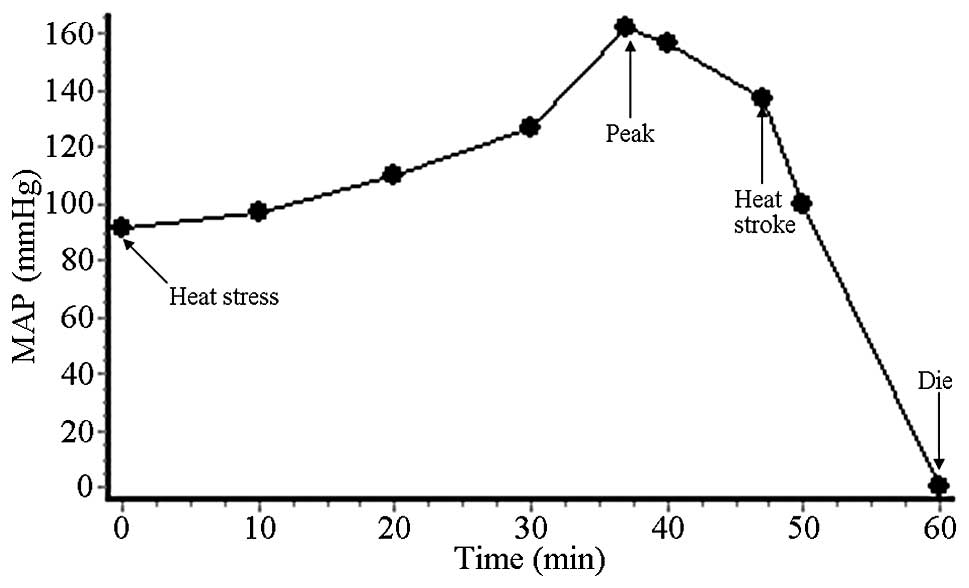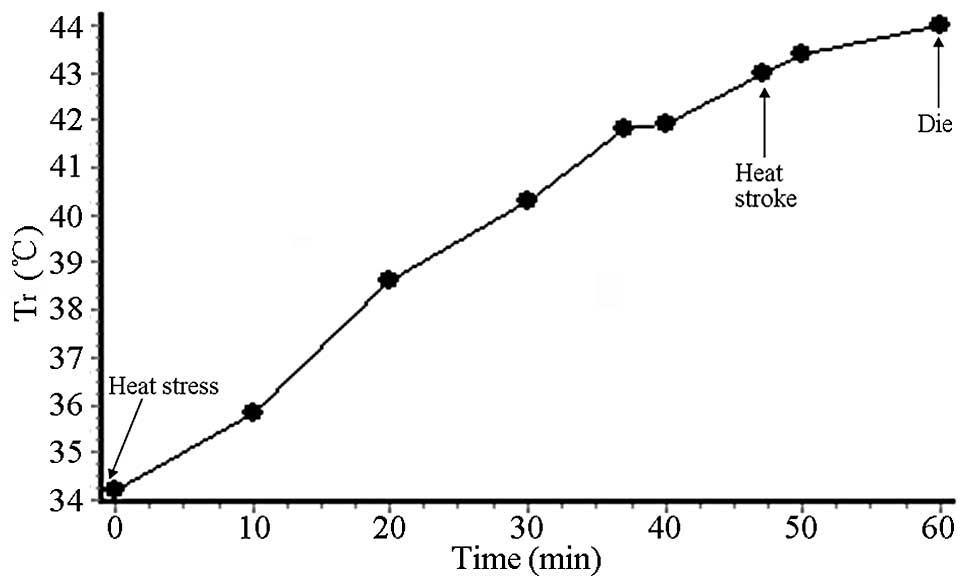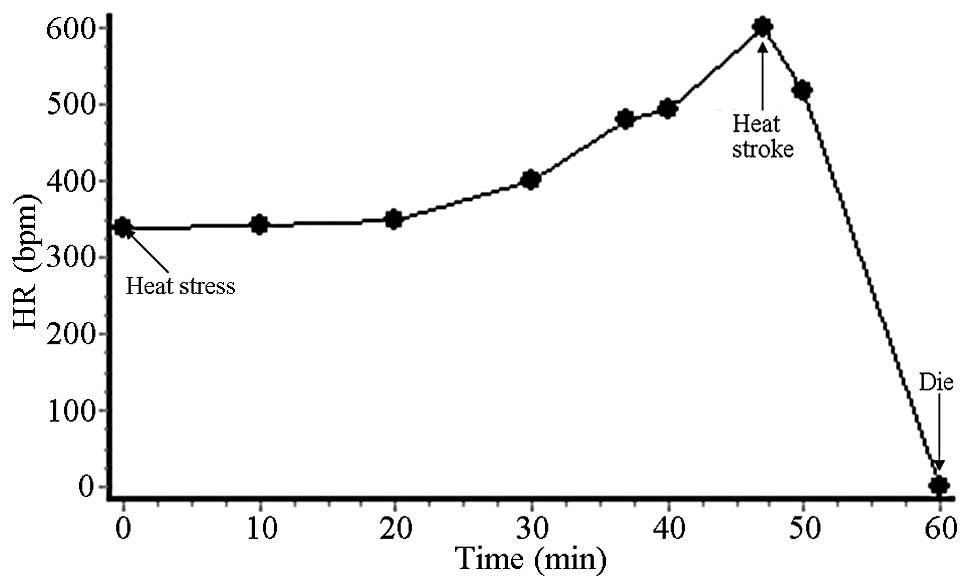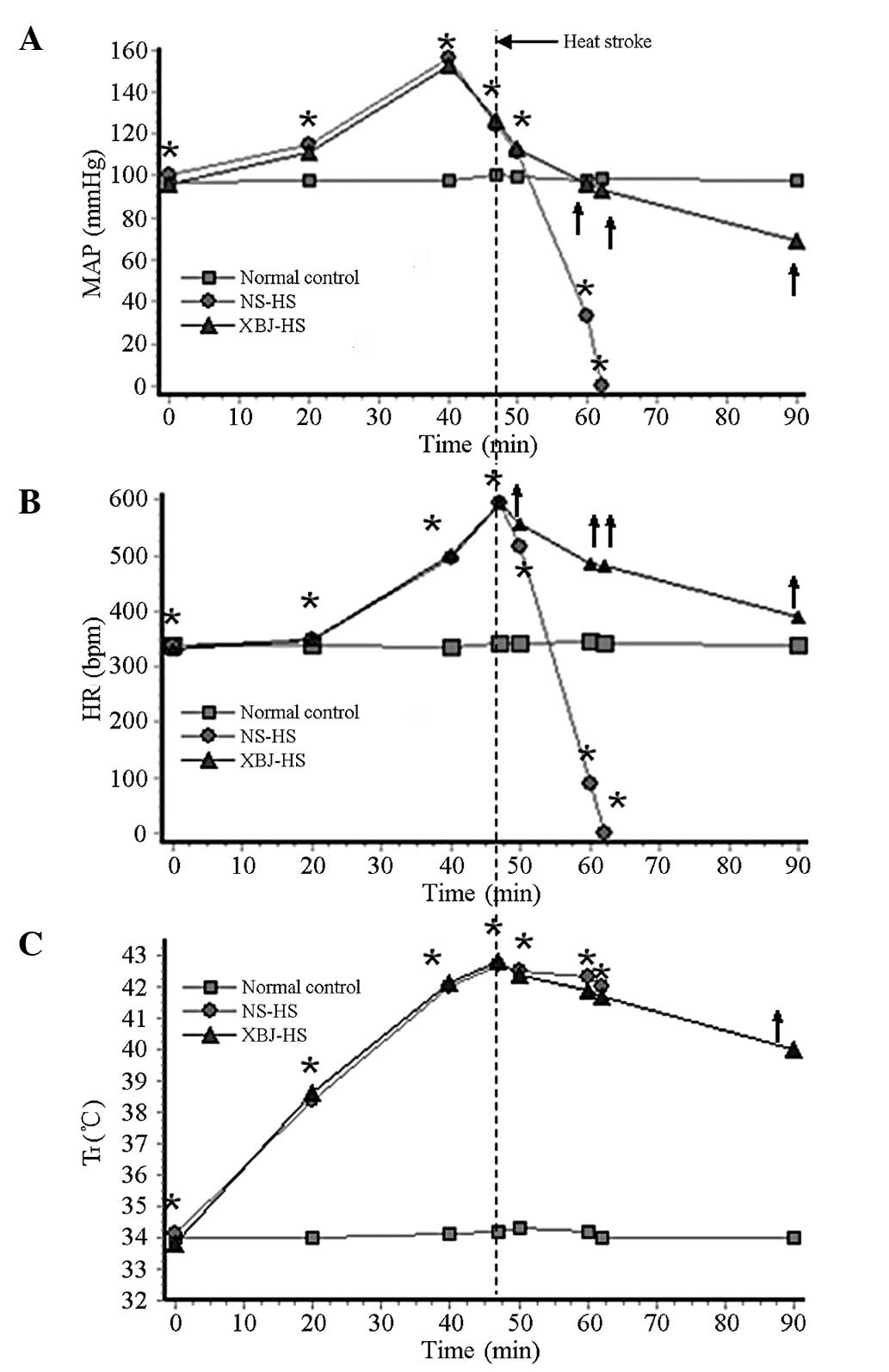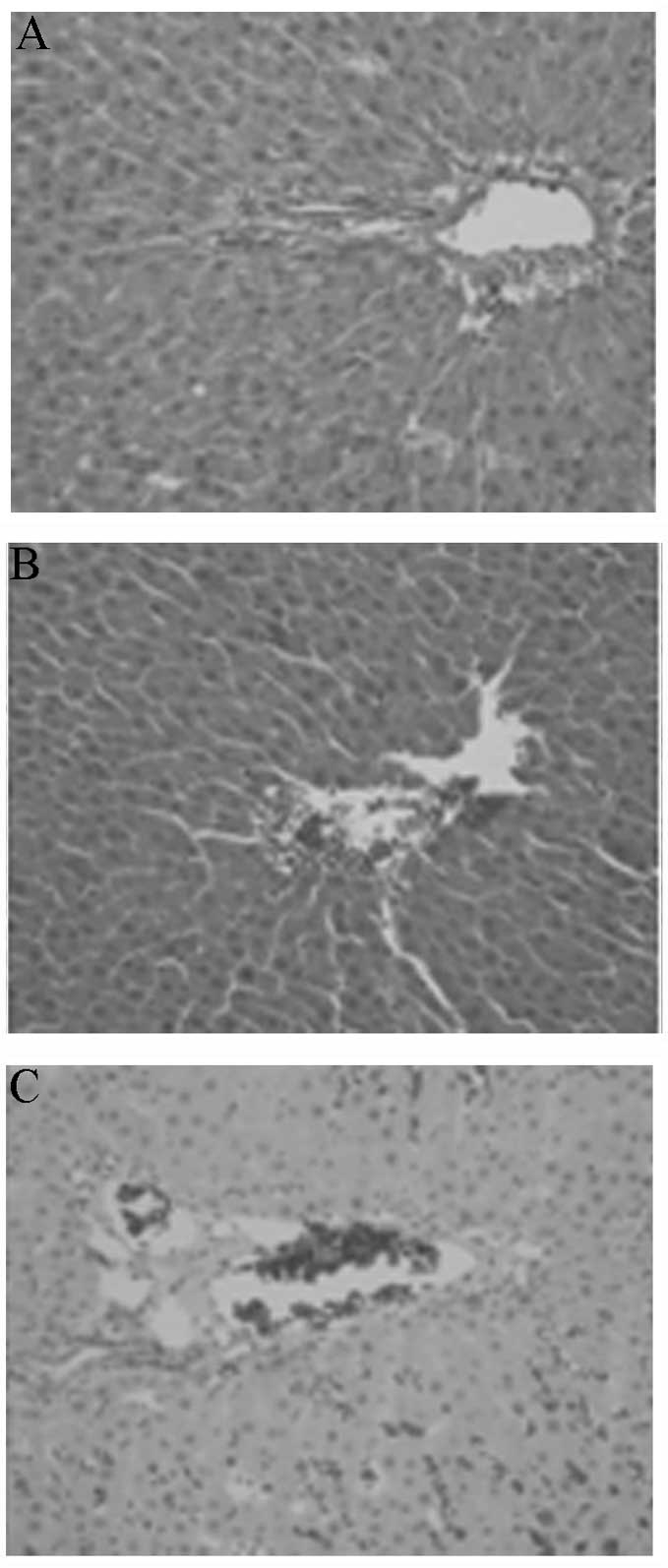|
1
|
Bouchama A and Knochel JP: Heat stroke. N
Engl J Med. 346:1978–1988. 2002. View Article : Google Scholar
|
|
2
|
Leon LR and Helwig BG: Heat stroke: role
of the systemic inflammatory response. J Appl Physiol (1985).
109:1980–1988. 2010. View Article : Google Scholar : PubMed/NCBI
|
|
3
|
Misset B, De Jonghe B, Bastuji-Garin S, et
al: Mortality of patients with heatstroke admitted to intensive
care units during the 2003 heat wave in France: a national
multiple-center risk-factor study. Crit Care Med. 34:1087–1092.
2006. View Article : Google Scholar : PubMed/NCBI
|
|
4
|
Grogan H and Hopkins PM: Heat stroke:
implications for critical care and anaesthesia. Br J Anaesth.
88:700–707. 2002. View Article : Google Scholar : PubMed/NCBI
|
|
5
|
Sun X, Lu D, Lv T and Mao Y: Effects of
Xuebijing injection on serum protein level in early phase of septic
rats. Zhongguo Zhong Yao Za Zhi. 35:223–225. 2010.In Chinese).;
|
|
6
|
Hashim IA, Al-Zeer A, Al-Shohaib S,
Al-Ahwal M and Shenkin A: Cytokine changes in patients with
heatstroke during pilgrimage to Makkah. Mediators Inflamm.
6:135–139. 1997. View Article : Google Scholar : PubMed/NCBI
|
|
7
|
Huang H, Ji L, Song S, et al:
Identification of the major constituents in Xuebijing injection by
HPLC-ESI-MS. Phytochem Anal. 22:330–338. 2011. View Article : Google Scholar : PubMed/NCBI
|
|
8
|
Li YP, Qiao YJ, Wu ZX, et al: Effects of
Xuebijing injection on thrombomodulin and endothelial cell protein
C receptor in septic rats. Zhongguo Wei Zhong Bing Ji Jiu Yi Xue.
19:365–368. 2007.(In Chinese).
|
|
9
|
Wu CC, Liao MH, Chen SJ and Yen MH:
Tetramethylpyradizine prevents inducible NO synthase expression and
improves survival in rodent models of endotoxic shock. Naunyn
Schmiedebergs Arch Pharmacol. 360:435–444. 1999. View Article : Google Scholar : PubMed/NCBI
|
|
10
|
Wan JM, Sit WH, Lee CL, Fu KH and Chan DK:
Protection of lethal toxicity of endotoxin by Salvia
miltiorrhiza BUNGE is via reduction in tumor necrosis factor
alpha release and liver injury. Int Immunopharmacol. 6:750–758.
2006.PubMed/NCBI
|
|
11
|
Wang H, Li W, Li J, et al: The aqueous
extract of a popular herbal nutrient supplement, Angelica
sinensis, protects mice against lethal endotoxemia and sepsis.
J Nutr. 136:360–365. 2006.PubMed/NCBI
|
|
12
|
Li YP, Qiao YJ, Wu ZX, Yao YM, Yu Y and Wu
Y: Effects of Xuebijing injection on high-mobility group box
chromosomal protein 1 in septic rats. Zhongguo Wei Zhong Bing Ji
Jiu Yi Xue. 19:239–241. 2007.(In Chinese).
|
|
13
|
Genfa L, Jiang Z, Hong Z, et al: The
screening and isolation of an effective anti-endotoxin monomer from
Radix Paeoniae Rubra using affinity biosensor technology.
Int Immunopharmacol. 5:1007–1017. 2005. View Article : Google Scholar : PubMed/NCBI
|
|
14
|
Bouchama A, Parhar RS, el-Yazigi A, Sheth
K and al-Sedairy S: Endotoxemia and release of tumor necrosis
factor and interleukin 1 alpha in acute heatstroke. J Appl Physiol
(1985). 70:2640–2644. 1991.PubMed/NCBI
|
|
15
|
Koch AE, Kunkel SL and Strieter RM:
Cytokines in rheumatoid arthritis. J Investig Med. 43:28–38.
1995.PubMed/NCBI
|
|
16
|
Chang DM: The role of cytokines in
heatstroke. Immunol Invest. 22:553–561. 1993. View Article : Google Scholar : PubMed/NCBI
|
|
17
|
Lin MT, Liu HH and Yang YL: Involvement of
interleukin-1 receptor mechanisms in development of arterial
hypotension in rat heatstroke. Am J Physiol. 273:H2072–H2077.
1997.PubMed/NCBI
|
|
18
|
Chiu WT, Kao TY and Lin MT: Increased
survival in experimental rat heatstroke by continuous perfusion of
interleukin-1 receptor antagonist. Neurosci Res. 24:159–163. 1996.
View Article : Google Scholar : PubMed/NCBI
|
|
19
|
Roberts GT, Ghebeh H, Chishti MA, et al:
Microvascular injury, thrombosis, inflammation, and apoptosis in
the pathogenesis of heatstroke: a study in baboon model.
Arterioscler Thromb Vasc Biol. 28:1130–1136. 2008. View Article : Google Scholar : PubMed/NCBI
|
|
20
|
Yao XQ, Zhang YH and Sun CH: Protective
effects of Xuebijing effervescent tablet on vital organs in rats
with toxic injury induced by endotoxin. Zhongguo Wei Zhong Bing Ji
Jiu Yi Xue. 24:357–359. 2012.(In Chinese).
|
|
21
|
Lee JJ, Lin MT, Wang NL, Lin CL and Chang
CK: Platonin, a cyanine photosensitizing dye, causes attenuation of
circulatory shock, hypercoagulable state, and tissue ischemia
during heat stroke. Shock. 24:577–582. 2005. View Article : Google Scholar : PubMed/NCBI
|
|
22
|
Jilma B and Derhaschnig U: Disseminated
intravascular coagulation in heat stroke: a hot topic. Crit Care
Med. 40:1370–1372. 2012. View Article : Google Scholar : PubMed/NCBI
|
|
23
|
Li CS, Jin M, Wu JY and Wu CJ: Effect of
XueBiJing injection upon related proinflammatory factors and blood
coagulation factors of vascular endothelial cells in severe septic
patients. Zhonghua Yi Xue Za Zhi. 89:2744–2747. 2009.(In
Chinese).
|
|
24
|
Yin DM, Sun Q, Li YP, Dong N and Yao YM:
Effects of Xuebijing injection on levels of tissue factor-bearing
microparticles in peripheral blood in septic rats. Zhongguo Wei
Zhong Bing Ji Jiu Yi Xue. 21:564–565. 2009.(In Chinese).
|
|
25
|
Sun X, Lu D, Lv T and Mao Y: Effects of
Xuebijing injection on serum protein level in early phase of septic
rats. Zhongguo Zhong Yao Za Zhi. 35:223–225. 2010.(In Chinese).
|
|
26
|
Gao YL, Chai YF and Yao YM: Advancement in
the research of mechanism of immune dysfunction in sepsis and the
regulatory effects of Xuebijing injection. Zhonghua Shao Shang Za
Zhi. 29:162–165. 2013.(In Chinese).
|
|
27
|
Diller KR and Zhu L: Hypothermia therapy
for brain injury. Annu Rev Biomed Eng. 11:135–162. 2009. View Article : Google Scholar
|
|
28
|
Yenari MA and Hemmen TM: Therapeutic
hypothermia for brain ischemia: where have we come and where do we
go? Stroke. 41(10 Suppl): S72–S74. 2010. View Article : Google Scholar : PubMed/NCBI
|
|
29
|
Mattis JG and Yates AM: Heat stroke:
helping patients keep their cool. Nurse Pract. 36:48–52. 2011.
View Article : Google Scholar : PubMed/NCBI
|















